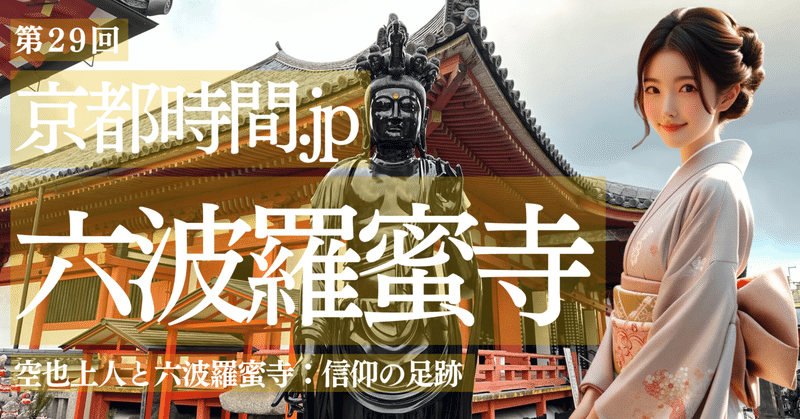
【京都時間.jp】第29回 空也上人と六波羅蜜寺:信仰の足跡
京都の歴史を刻む六波羅蜜寺は、日本の精神性の核となる場所です。その始まりは、市聖空也が造立した十一面観音を拝む道場に遡ります。平安時代、京都を襲った疫病の中、空也はこの観音像を車に乗せて街を巡り、病める人々に念仏を唱え、茶を振る舞いました。彼の慈悲深い行動は、混乱と苦悩の時代に光をもたらし、後世に大きな影響を与えました。

空也の死後、寺は比叡山延暦寺の僧・中信によって再興され、天台宗に属する天台別院「六波羅蜜寺」として栄えました。寺名の由来は、仏教の「六波羅蜜」という教義に加え、この地がかつて「六原」と呼ばれていたことにも因んでいます。平安時代末期には、平家の影響力が増し、平忠盛が当寺の塔頭に軍勢を駐屯させるなど、政治的な重要拠点としての役割も果たしました。

平家の没落に伴い、寺は火災に見舞われ、多くの建物が焼失しましたが、その後、源頼朝や足利義詮によって再建され、豊臣秀吉による本堂の修復、徳川将軍家による保護など、時代の変遷と共に、何度も再興を遂げてきました。現在の本堂は1363年に建てられたもので、1969年の大規模な修復では、創建当時の貴重な遺物が多数発掘されました。

六波羅蜜寺を創建した空也上人は、苦行と献身の人生を送りました。五畿七道を巡り、尾張国分寺で出家後、教義の奥義を極め、人々に念仏を説き続けました。彼の鞍馬山での隠居生活や、愛した鹿との逸話は、彼の深い慈悲心を物語っています。市民に深く愛され、「市の聖」と呼ばれた彼の遺徳は、今も多くの人々に感銘を与えています。

寺院の本堂やその他の建造物は、その荘厳さと美しさで訪れる者を魅了します。重要文化財である空也上人立像や平清盛坐像は、彼らの生きた時代の息吹を今に伝える芸術作品です。また、寺院には都七福神草創六百年記念事業として、金印が授与されています。これは、室町時代から続く七福神信仰の歴史を讃えるもので、多くの信仰者に親しまれています。

歴史の重みと静けさが共存する境内を歩きながら、過去の出来事が目の前に浮かんでくるようでした。この古刹は、ただの観光地ではなく、日本の歴史と文化が息づく聖地です。寺が紡ぐ物語は、訪れるすべての人々に深い感動を与えます。六波羅蜜寺は、歴史愛好家だけでなく、日本文化や仏教芸術に興味を持つ人々にとっても必見の場所です。寺院の壮大な歴史と美しい建築、そしてそこに宿る平穏な精神性は、訪れるすべての人々に深い感動を与えるのです。ここには、日本の歴史の一部が生き生きと息づいており、訪問者に無言の物語を語りかけてきます。

The Rokuharamitsu-ji Temple in Kyoto, a place marking the essence of Japan's spirituality, traces its origins back to a dojo established for worshiping the eleven-faced Kannon by the city's saint, Kuya. During the Heian period, amid an epidemic in Kyoto, Kuya placed this Kannon statue on a cart, parading through the city, reciting prayers, and serving tea to the sick. His compassionate actions brought light during times of chaos and suffering, leaving a significant impact on later generations.
After Kuya's death, the temple was revived by Chushin, a monk from Enryaku-ji Temple on Mount Hiei, flourishing as a Tendai sect branch, "Rokuharamitsu-ji." The temple's name derives from the Buddhist doctrine of "Rokuharamitsu" and the area's former name, "Roku-hara." In the late Heian period, under the influence of the Taira clan, Tadamori used the temple as a military base, marking its role as a political stronghold.
Following the Taira clan's fall, the temple suffered fire damage, destroying many buildings. However, it was rebuilt by Minamoto no Yoritomo and Ashikaga Yoshiakira, with further restorations by Toyotomi Hideyoshi and protection from the Tokugawa shogunate. The current main hall, built in 1363, underwent extensive repairs in 1969, uncovering many valuable artifacts from its founding period.
Kuya, the temple's founder, led a life of asceticism and devotion. After ordination at Owari Kokubun-ji, he traveled through Gokishichido, mastering doctrine and continually preaching. His reclusive life on Mount Kurama and anecdotes with a beloved deer highlight his deep compassion. Deeply loved by citizens and known as "the city's saint," his virtues continue to inspire many.
The temple's main hall and other buildings captivate visitors with their majesty and beauty. The important cultural properties, standing statues of Kuya and seated statues of Taira no Kiyomori, are artistic works conveying the breath of their era. The temple also received a gold seal in recognition of the 600-year anniversary of the Seven Lucky Gods faith, a tradition since the Muromachi period, cherished by many believers.
Walking through the grounds where history's weight and tranquility coexist, past events seem to come alive. This ancient temple, more than a tourist spot, is a sacred place where Japan's history and culture thrive. The stories woven by the temple profoundly move all visitors. Rokuharamitsu-ji is a must-see not only for history enthusiasts but also for those interested in Japanese culture and Buddhist art. Its grand history, beautiful architecture, and serene spirituality profoundly impact all visitors, silently narrating a part of Japan's vibrant history.
この記事が気に入ったらサポートをしてみませんか?
